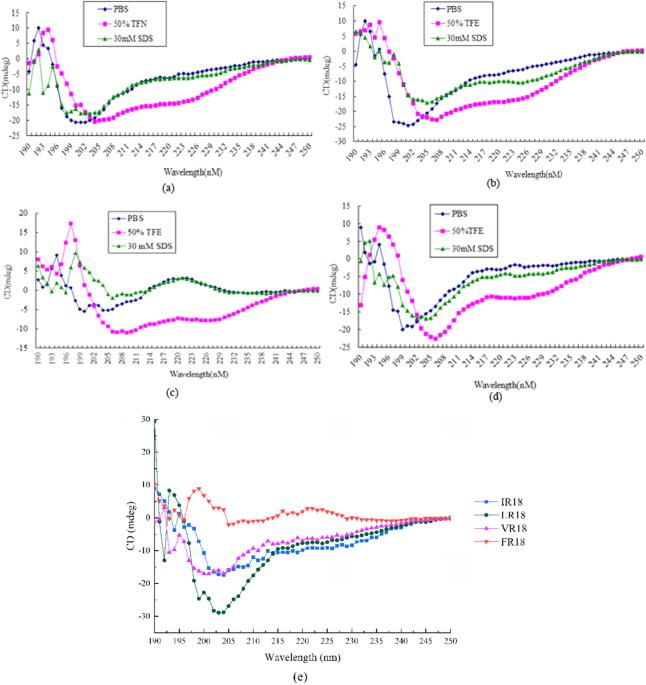以 PRRP 为中轴的高治疗指数抗菌肽的设计、生物学特性和抗菌机制
IF 2.1
4区 医学
Q3 BIOTECHNOLOGY & APPLIED MICROBIOLOGY
引用次数: 0
摘要
作为生物先天免疫的重要组成部分,抗菌肽(AMPs)存在于昆虫、植物、动物、细菌、真菌等多种生物体内。然而,天然 AMPs 的高溶血活性、高毒性和低稳定性严重阻碍了它们作为治疗药物的应用。为了克服这些问题,本研究以 PRRP 为中轴,以 XRRXXRXPRRPXRXXRRX-NH2 为序列模板设计多肽,其中 X 代表 Phe (F)、Ile (I)、Val (V) 和 Leu (L) 等疏水氨基酸。所设计的多肽 LR18、FR18 和 IR18 对一些革兰氏阳性菌和革兰氏阴性菌具有有效的抗菌活性,对哺乳动物细胞的细胞毒性较低,并倾向于在膜模拟环境中形成 α 螺旋结构。其中,肽 LR18(X:L)对革兰氏阴性菌的几何平均处理指数(GMTI = 42.7)最高,而 FR18(X:L)对革兰氏阳性菌的几何平均处理指数(GMTI)(22.86)最高。LR18 和 FR18 还表现出更好的盐、温度、pH 值和胰蛋白酶稳定性。LR18 和 FR18 主要通过破坏细菌细胞膜发挥抗菌作用。简而言之,多肽 LR18 和 FR18 具有较高的治疗指数和稳定性,因此有可能作为一种治疗剂来减少抗生素耐药性。本文章由计算机程序翻译,如有差异,请以英文原文为准。


Design, biological characteristics, and antibacterial mechanism of high therapeutic index antimicrobial peptides with PRRP as central axis
As the important components of biological innate immunity, antimicrobial peptides (AMPs) were found in a variety of organisms including insects, plants, animals, bacteria, fungi, etc. However, high hemolytic activity, high toxicity, and poor stability of natural AMPs hinder serious their application as therapeutic agents. To overcome these problems, in this study we use PRRP as a central axis, and peptides were designed based on the sequence template XRRXXRXPRRPXRXXRRX-NH2, where X represents a hydrophobic amino acid like Phe (F), Ile (I), Val (V), and Leu (L). The designed peptides LR18, FR18, and IR18 showed effective antimicrobial activity against some Gram-positive bacteria and Gram-negative bacteria, low cytotoxicity to mammalian cells, and had a tendency to form α-helical structures in membrane-mimetic environments. Among them, peptide LR18 (X: L) showed the highest geometric mean average treatment index (GMTI = 42.7) against Gram-negative bacteria, and FR18 (X: L) showed the highest GMTI (22.86) against Gram-positive bacteria. LR18 and FR18 also showed better salt, temperature, pH, and trypsin stability. LR18 and FR18 exert their antimicrobial effects mainly through destroying bacteria cell membrane. Briefly, peptide LR18 and FR18 have the potential to serve as a therapeutic agent to reduce antibiotic resistance owing to its high therapeutic index and great stability.
求助全文
通过发布文献求助,成功后即可免费获取论文全文。
去求助
来源期刊

Journal of Antibiotics
医学-免疫学
CiteScore
6.60
自引率
3.00%
发文量
87
审稿时长
1 months
期刊介绍:
The Journal of Antibiotics seeks to promote research on antibiotics and related types of biologically active substances and publishes Articles, Review Articles, Brief Communication, Correspondence and other specially commissioned reports. The Journal of Antibiotics accepts papers on biochemical, chemical, microbiological and pharmacological studies. However, studies regarding human therapy do not fall under the journal’s scope. Contributions regarding recently discovered antibiotics and biologically active microbial products are particularly encouraged. Topics of particular interest within the journal''s scope include, but are not limited to, those listed below:
Discovery of new antibiotics and related types of biologically active substances
Production, isolation, characterization, structural elucidation, chemical synthesis and derivatization, biological activities, mechanisms of action, and structure-activity relationships of antibiotics and related types of biologically active substances
Biosynthesis, bioconversion, taxonomy and genetic studies on producing microorganisms, as well as improvement of production of antibiotics and related types of biologically active substances
Novel physical, chemical, biochemical, microbiological or pharmacological methods for detection, assay, determination, structural elucidation and evaluation of antibiotics and related types of biologically active substances
Newly found properties, mechanisms of action and resistance-development of antibiotics and related types of biologically active substances.
 求助内容:
求助内容: 应助结果提醒方式:
应助结果提醒方式:


